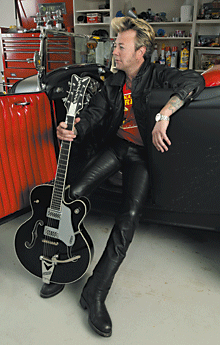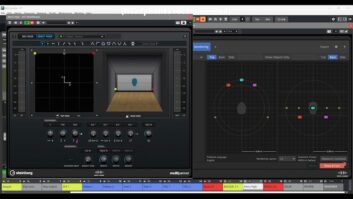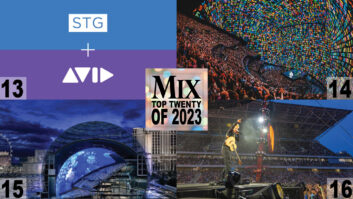
Brian Setzer makes a lot of great albums, but he doesn’t spend a lot of time in studios. His MO is to begin a new project well-prepared, whether that means writing charts for his 18-piece big band — the Brian Setzer Orchestra — or just bringing in the right rock ‘n’ roll crew that can speak his musical language and nail a song on the first take. He doesn’t like to labor over sounds, and he doesn’t want to give music lessons. So he’s been happy to work with the same producer/engineer team — Dave Darling and Jeff Peters, respectively — on his past six-plus albums.
“Dave is a producer, but he’s also a musician,” Setzer says. “I need someone who reads and writes music like I do. I can’t say to most producers, ‘That minor-seven-flat-five, there’s something wrong with that chord.’ Most producers don’t know what you’re talking about, but we speak the same language and we get the job done twice as quick. We’ll look at each other when a wrong note goes by, or we’ll be in a mix and I’ll start to say, ‘The guitar is…’ and he’ll say, ‘The second verse could be louder.’ We finish each other’s sentences.”
Darling and Peters started working with Setzer in 2000 when the producer and engineer were brought in to remix a couple of songs on the Brian Setzer Orchestra album Vavoom!, including the single “Pennsylvania 6-5000.” “I did a remix version of that tune with a lot of added material — strange-sounding stuff — and Brian’s manager and the guys from Interscope loved it, but they thought Brian would hate it because they think of him as a purist,” Darling says. “He’s not just a purist; he just has an enormous amount of respect for the type of music he’s doing.”
Working with Darling, Setzer has been able to push the envelope in all of his musical incarnations. He may still make 1950s-style rockabilly records occasionally, but he also feels free to experiment, and his latest album, 13, takes him way outside that box. 13 is punk, it’s rockabilly, it’s rock, surf, sci-fi — it’s all original Setzer, and it’s probably the album that best displays his guitar virtuosity.
“Brian continues to amaze me as a guitar player,” Peters says. “I think he’s one of the most underrated guitar players there is. The rock riffs he came up with on this record are fantastic.”
Setzer began making 13 by recording some simple demos and sending them to the core bandmembers — drummer Bernie Dresel and stand-up bassist Ronnie Crutcher — so they could begin thinking about their parts. Then he went into Pachyderm Studio, a professional facility that’s set in an arts-and-crafts house about half-an-hour from Minneapolis (Setzer’s newish hometown) to track Setzer’s guitars and electric bass, and Dresel’s drums to Pro Tools with the help of operator/staff engineer Brent Sigmeth.
“To get a good rhythm track, you’ve got to have that big gymnasium room,” Setzer says. “A lot of people think they can make records in their closet, but I need that big open room and a wood floor.”
The high-end Pachyderm Studio has that great big tracking room, as well as a large Neve 8068-centered control room with Genelec, Tannoy and Westlake monitors. Peters used some of the modules in the Neve, but he also brought along his own arsenal of rack gear, plug-ins and mics. “I’m a fan of the Great River products,” he says, “so I used a lot of those preamps for guitars and vocals.”
Setzer sang into a Neumann M49 microphone. “For the big band projects, we use the RCA 77DX,” Peters explains, “but on 13, we wanted more of a classic rock sound and the M49 sounded fantastic on his voice. Same thing with guitars. This time we did close-miking with an SM57 and a Sennheiser 409. I’ve traditionally been using an RCA 44 or the AEA 44 for Brian, but we wanted a different sound.”
Different guitar sounds were also realized with different guitars. Setzer’s gear on this album included a new Gretsch SSLVO and another hot-rod Gretsch. “I didn’t use any old guitars,” Setzer says. “First time I’ve ever done that. I plugged them in and they just sounded so good. This is more a ‘rock’ than a ‘billy’ record. They just cranked a little better.”
Darling also got Setzer unwittingly to experiment with different amps. “Brian generally uses Gretsch guitars and Bassman amps,” he says, “and he gets all the tone out of his fingers. But a few records back, he started using some smaller amps — Supro and some vintage amps that were crunchier. This record, since we knew going in we were going to experiment a little bit, I put a secret amp in the hallway, another amp in a different room and a bank of pedals on it, and I’d go out there and stomp and hope Brian wouldn’t figure out what I was doing and fire me.”
After the basic tracking in Pachyderm, the project moved to Flowers Studio in the Uptown neighborhood of Minneapolis. Flowers — which offers a vintage Trident 80 Series board, a wide array of mics and outboard and UREI 813B mains — is a smaller, artist-oriented facility owned by producer/engineer Ed Ackerson. There, they recorded more instruments, overdubs and more guitars.
“It’s actually an old flower shop,” Setzer says. “It’s a cool room. The guy [Ackerson] has a million guitars and a million amps, and it’s fun to fool around with all that stuff: ‘Get that old Vox amp. Let me plug the Rickenbacker into that thing.’ That’s what happened there. Incendiary things like having a whole slew of guitars laying out sometimes makes a big difference.”
One of the songs that blended guitar tracks from both studios was “Bad Bad Girl,” which Darling describes as “Japanese sci-fi surf.” “In Pachyderm, we did the basic track,” he explains. “We did that several times, actually, because we kept speeding it up until it was pretty frenetic. By the time we got to the overdubs, we decided to do a double drum set on it. I think it started out as a ride overdub, but Bernie Dresel started playing the kick and it had this off-kilter ’70s vibe to it, so we kept it. And then every overdub we made, we just made sure if fit the criteria of Japanese sci-fi surf. If it wasn’t Japanese, sci-fi or surf, it didn’t live!”
“That’s a really kooky track,” Setzer says. “I play a crazy augmented scale, and then I played the whole-tone scale down. And I wanted it to sound like a Shamisen, the Japanese string instrument. So I just tuned up a tenor banjo, and we did a lot of other weird tricks on that. It almost sounds like there’s something going backward or overdriven. The song became more surreal as we worked on it. I love songs like that because it’s a rockabilly song, but it’s got all this weird, crazy stuff most guys wouldn’t have thought about doing back then.”
“Guitarists, or just about anyone, are going to like that he stepped out of the traditional thing, and it shows that he’s capable of just about anything,” Peters observes.
Darling mixed 13 on his own in Pro Tools at a friend Rodger Carter’s L.A. studio called The Doghouse. “Brian’s comfortable knowing he can leave and I’ll get it done,” Darling says. “We discussed things before I went in to mix, and we wanted to put an aggressive, modern-sounding mix on an otherwise almost retro record. Some of the things that can take a lot of time on other records don’t take a lot of time with his. Every time he plays a solo, it’s a keeper. It’s more about deciding what we want, not if it’s good enough. And we talked about the fact that what we wanted was extremes. If it’s a loud song, let’s make it really loud. If it’s an odd song, let’s make it really odd. If it’s a fast song, let’s make it really fast! He probably could have called the record ‘Really.’”






